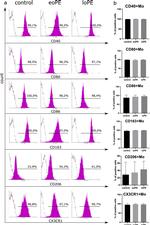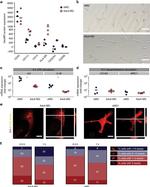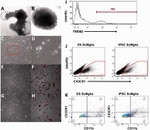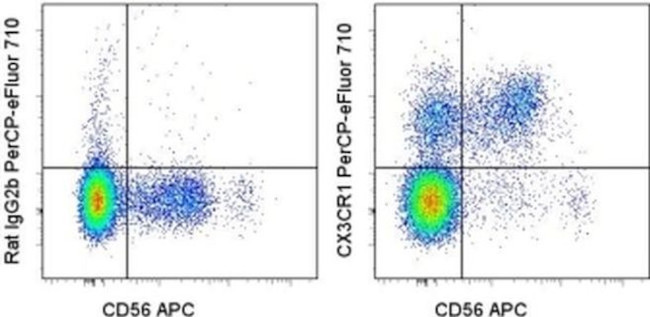Search Thermo Fisher Scientific
Invitrogen
CX3CR1 Monoclonal Antibody (2A9-1), PerCP-eFluor™ 710, eBioscience™
图: 1 / 4
CX3CR1 Antibody (46-6099-42) in Flow




产品信息
46-6099-42
种属反应
已发表种属
宿主/亚型
分类
类型
克隆号
偶联物
激发/发射光谱
形式
浓度
纯化类型
保存液
内含物
保存条件
运输条件
RRID
产品详细信息
Description: This 2A9-1 monoclonal antibody reacts with human CX3CR1, which is the receptor for fractalkine, a transmembrane chemokine of the CX3C family. CX3CR1 is a seven transmembrane G protein-coupled receptor expressed on CD16+ NK cells, T cells (e.g. CD8+, CD4+, and gamma/delta), and monocytes. In non-immune cells, CX3CR1 has been found on osteoclast precursors and microglia. Little to no CX3CR1 surface expression can be detected on B cells and granulocytes. Together, fractalkine and its receptor mediate cell-cell adhesion and chemotaxis of NK cells, T cells, and monocytes. The expression of CX3CR1 has also been correlated with high levels of intracellular perforin and granzyme B.
Applications Reported: This 2A9-1 antibody has been reported for use in flow cytometric analysis.
Applications Tested: This 2A9-1 antibody has been pre-titrated and tested by flow cytometric analysis of normal human peripheral blood cells. This can be used at 5 µL (0.25 µg) per test. A test is defined as the amount (µg) of antibody that will stain a cell sample in a final volume of 100 µL. Cell number should be determined empirically but can range from 10^5 to 10^8 cells/test.
PerCP-eFluor® 710 can be used in place of PE-Cy5, PE-Cy5.5 or PerCP-Cy5.5. PerCP-eFluor® 710 emits at 710 nm and is excited with the blue laser (488 nm). Please make sure that your instrument is capable of detecting this fluorochrome. For a filter configuration, we recommend using the 685 LP dichroic mirror and 710/40 band pass filter, however the 695/40 band pass filter is an acceptable alternative.
Our testing indicates that PerCP-eFluor® 710 conjugated antibodies are stable when stained samples are exposed to freshly prepared 2% formaldehyde overnight at 4°C, but please evaluate for alternative fixation protocols.
Excitation: 488 nm; Emission: 710 nm; Laser: Blue Laser.
Filtration: 0.2 µm post-manufacturing filtered.
靶标信息
CX3CR1 is one of the chemokine receptors that are required as coreceptors for HIV infection. The genes encoding human, mouse, and rat CX3CR1 were cloned and designated V28 and CMKBRL1, CX3CR1, and RBS11, respectively. The encoded seven transmembrane protein was recently identified as the receptor for a novel transmembrane molecule, fractalkine, and renamed CX3CR1. Recently, CX3CR1 was found to serve as a coreceptor for HIV-1 and HIV-2 envelope fusion and virus infection, which can be inhibited by fractokine. CX3CR1 mediates leukocyte migration an d adhesion. CX3CR1 is expressed in a variety of human tissues and cell lines.
仅用于科研。不用于诊断过程。未经明确授权不得转售。
How to use the Panel Builder
Watch the video to learn how to use the Invitrogen Flow Cytometry Panel Builder to build your next flow cytometry panel in 5 easy steps.
生物信息学
蛋白别名: Beta chemokine receptor-like 1; C-X3-C CKR-1; chemokine (C-C) receptor-like 1; chemokine (C-X3-C motif) receptor 1; chemokine (C-X3-C) receptor 1; CMK-BRL-1; CMK-BRL1; Cx3c; CX3C chemokine receptor 1; Fractalkine receptor; G protein-coupled receptor 13; G-protein coupled receptor 13; Scyd1; V28
基因别名: CCRL1; CMKBRL1; CMKDR1; CX3CR1; GPR13; GPRV28; V28
UniProt ID: (Human) P49238
Entrez Gene ID: (Human) 1524




